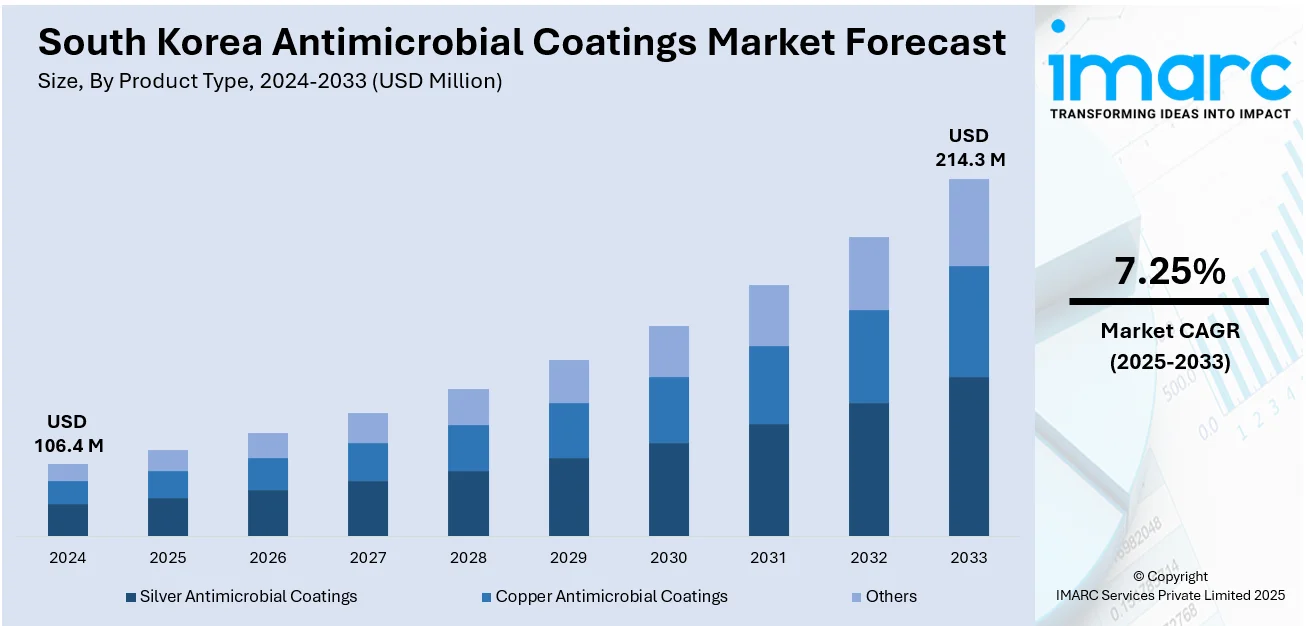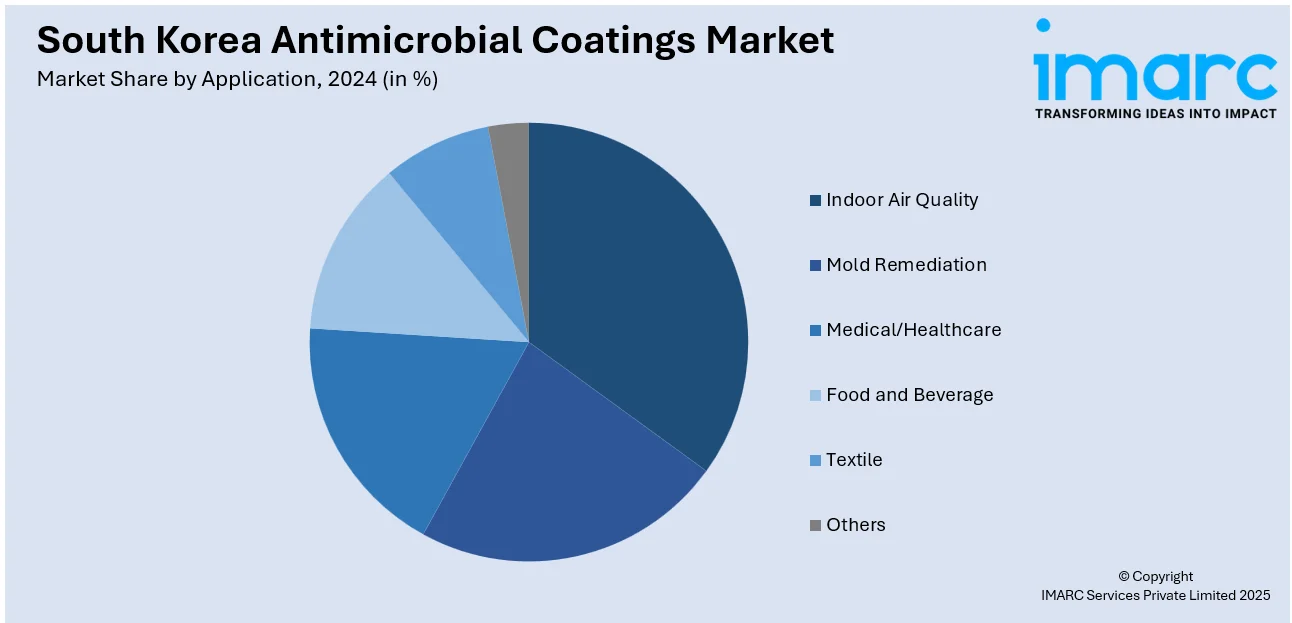
South Korea Antimicrobial Coatings Market Size, Share, Trends and Forecast by Product Type, Application, and Region, 2025-2033
South Korea Antimicrobial Coatings Market Overview:
The South Korea antimicrobial coatings market size reached USD 106.4 Million in 2024. Looking forward, IMARC Group expects the market to reach USD 214.3 Million by 2033, exhibiting a growth rate (CAGR) of 7.25% during 2025-2033. Rising hospital-acquired infections, consumer awareness of hygiene, stricter government regulations, and expanding healthcare infrastructure are some of the factors contributing to South Korea antimicrobial coatings market share. Demand grows in construction and electronics as well, as manufacturers integrate antimicrobial layers to enhance product safety and appeal in residential and commercial spaces.
|
Report Attribute
|
Key Statistics
|
|---|---|
|
Base Year
|
2024
|
|
Forecast Years
|
2025-2033
|
|
Historical Years
|
2019-2024
|
| Market Size in 2024 | USD 106.4 Million |
| Market Forecast in 2033 | USD 214.3 Million |
| Market Growth Rate 2025-2033 | 7.25% |
South Korea Antimicrobial Coatings Market Trends:
High-Tech Integration Driving New Formulations
South Korea’s strong tech base is encouraging coating makers to blend antimicrobial features with smart functions. Companies are combining nanotechnology with IoT-linked surfaces in hospitals, transit hubs, and smart buildings. These coatings are designed not only to block bacteria but also to signal when disinfection is needed or when surface hygiene drops below safe levels. Local R&D teams, backed by partnerships with universities and semiconductor firms, are exploring how to embed sensors within coating layers. This trend ties into the country’s broader push for smart infrastructure and public health resilience. COVID-19 shifted public attitudes toward hygiene, so demand for advanced, low-maintenance protection remains high. Builders and facility managers see value in coatings that reduce manual cleaning while offering real-time data. Such innovation means local firms are stepping away from simple silver- or copper-based formulas and moving into tailored solutions for schools, airports, and urban facilities. Export opportunities are also opening up as these smart coatings attract global buyers. These factors are intensifying the South Korea antimicrobial coatings market growth.

To get more information on this market, Request Sample
Eco-Friendly Alternatives Getting a Boost
South Korea’s environmental policies are reshaping the antimicrobial coatings scene. Manufacturers are rethinking solvent-heavy options and switching to water-based or bio-based coatings with lower VOC levels. Pressure comes from government rules and buyers who want greener buildings and public spaces. Traditional antimicrobial coatings rely on metal additives that can leach out, raising concerns about toxicity and waste. Local producers are testing plant-derived antimicrobial agents or biodegradable polymers. Schools and hospitals, in particular, want coatings that meet stricter indoor air quality standards. Green building certifications are driving adoption of sustainable options, especially for new projects under public-private partnerships. Mid-sized companies are gaining traction by pitching eco-friendly products that match South Korea’s carbon reduction goals. While these alternatives still cost more than legacy coatings, rising consumer awareness and incentives for green construction keep the market growing steadily. Exporters also see a chance to stand out in regions where sustainability is becoming a selling point.
South Korea Antimicrobial Coatings Market Segmentation:
IMARC Group provides an analysis of the key trends in each segment of the market, along with forecasts at the country and regional levels for 2025-2033. Our report has categorized the market based on product type and application.
Product Type Insights:
- Silver Antimicrobial Coatings
- Copper Antimicrobial Coatings
- Others
The report has provided a detailed breakup and analysis of the market based on the product type. This includes silver antimicrobial coatings, copper antimicrobial coatings, and others.
Application Insights:

- Indoor Air Quality
- Mold Remediation
- Medical/Healthcare
- Food and Beverage
- Textile
- Others
The report has provided a detailed breakup and analysis of the market based on the application. This includes indoor air quality, mold remediation, medical/healthcare, food and beverage, textile, and others.
Regional Insights:
- Seoul Capital Area
- Yeongnam (Southeastern Region)
- Honam (Southwestern Region)
- Hoseo (Central Region)
- Others
The report has also provided a comprehensive analysis of all the major regional markets, which include Seoul Capital Area, Yeongnam (Southeastern Region), Honam (Southwestern Region), Hoseo (Central Region), and others.
Competitive Landscape:
The market research report has also provided a comprehensive analysis of the competitive landscape. Competitive analysis such as market structure, key player positioning, top winning strategies, competitive dashboard, and company evaluation quadrant has been covered in the report. Also, detailed profiles of all major companies have been provided.
South Korea Antimicrobial Coatings Market News:
- In March 2024, a South Korean team from POSTECH and Kyungpook National University created a smart implant coating using mussel adhesion proteins. This coating releases antibiotics only when bacterial infections occur, targeting antibiotic-resistant bacteria and minimizing unnecessary antibiotic exposure. The technology adjusts antibiotic release based on infection severity, aiming to reduce implant failures and prevent superbugs. This innovation could boost South Korea’s antimicrobial coatings market with safer, more effective medical implants.
South Korea Antimicrobial Coatings Market Report Coverage:
| Report Features | Details |
|---|---|
| Base Year of the Analysis | 2024 |
| Historical Period | 2019-2024 |
| Forecast Period | 2025-2033 |
| Units | Million USD |
| Scope of the Report |
Exploration of Historical Trends and Market Outlook, Industry Catalysts and Challenges, Segment-Wise Historical and Future Market Assessment:
|
| Product Types Covered | Silver Antimicrobial Coatings, Copper Antimicrobial Coatings, Others |
| Applications Covered | Indoor Air Quality, Mold Remediation, Medical/Healthcare, Food and Beverage, Textile, Others |
| Regions Covered | Seoul Capital Area, Yeongnam (Southeastern Region), Honam (Southwestern Region), Hoseo (Central Region), Others |
| Customization Scope | 10% Free Customization |
| Post-Sale Analyst Support | 10-12 Weeks |
| Delivery Format | PDF and Excel through Email (We can also provide the editable version of the report in PPT/Word format on special request) |
Key Questions Answered in This Report:
- How has the South Korea antimicrobial coatings market performed so far and how will it perform in the coming years?
- What is the breakup of the South Korea antimicrobial coatings market on the basis of product type?
- What is the breakup of the South Korea antimicrobial coatings market on the basis of application?
- What is the breakup of the South Korea antimicrobial coatings market on the basis of region?
- What are the various stages in the value chain of the South Korea antimicrobial coatings market?
- What are the key driving factors and challenges in the South Korea antimicrobial coatings market?
- What is the structure of the South Korea antimicrobial coatings market and who are the key players?
- What is the degree of competition in the South Korea antimicrobial coatings market?
Key Benefits for Stakeholders:
- IMARC’s industry report offers a comprehensive quantitative analysis of various market segments, historical and current market trends, market forecasts, and dynamics of the South Korea antimicrobial coatings market from 2019-2033.
- The research report provides the latest information on the market drivers, challenges, and opportunities in the South Korea antimicrobial coatings market.
- Porter's five forces analysis assist stakeholders in assessing the impact of new entrants, competitive rivalry, supplier power, buyer power, and the threat of substitution. It helps stakeholders to analyze the level of competition within the South Korea antimicrobial coatings industry and its attractiveness.
- Competitive landscape allows stakeholders to understand their competitive environment and provides an insight into the current positions of key players in the market.
Need more help?
- Speak to our experienced analysts for insights on the current market scenarios.
- Include additional segments and countries to customize the report as per your requirement.
- Gain an unparalleled competitive advantage in your domain by understanding how to utilize the report and positively impacting your operations and revenue.
- For further assistance, please connect with our analysts.
 Request Customization
Request Customization
 Speak to an Analyst
Speak to an Analyst
 Request Brochure
Request Brochure
 Inquire Before Buying
Inquire Before Buying




.webp)




.webp)












